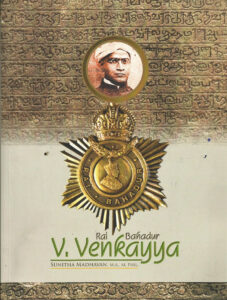Registered with the Registrar of Newspapers for India under R.N.I 53640/91
Vol. XXX No. 21, March 1-15, 2021
Rai Bahadur V. Venkayya – Pioneering epigraphist of India
Book Review by Dr. Chithra Madhavan

Rai Bahadur V.Venkayya, born in 1864 in the lineage of the illustrious scholar Appaya Dikshita of the 16th century, was one of the pioneering epigraphists of India and an expert in deciphering inscriptions etched on stone in the temples of South India, as well as the copper-plate inscriptions. He also deciphered the writing (legends) on coins. Trained in epigraphy by Dr. E. Hultzsch, the famous German epigraphist, he was the first Indian Epigraphist to the Government of India. In the words of John H. Marshall, Director General of the Archaeological Survey of India from 1902 to 1928, ‘From first to last, his life in the Archaeological Department was one of assiduous labour and devotion to duty and his work throughout was characterised by sound scholarship.’
As a boy, he had studied the Vedas and ancillary scriptures from his father, Appa Sitarama Ayyar, a profound Vedic scholar – a learning that was to stand him in good stead later in life. Venkayya’s schooling was in Chittoor, where he did extremely well despite dire financial straits, and went on to join the Madras Christian College (MCC). Staying in a hostel in Madras, he again felt the pangs of poverty, but bore all this with fortitude, writing in his diary, ` I cannot altogether forget the humiliating position which I occupied both at Chittoor, when I was preparing for my Matric examination and at the Student’s Home, Madras. Perhaps, but for the pinching poverty throughout the period of my education, I might not have made much progress. In fact, poverty has been my best friend’. He subsequently joined the Free Church Mission High School (Anderson School) in Kanchipuram in 1885 and remitted money back home to educate his siblings. He made good use of his stay in Kanchipuram to visit the glorious temples in this ancient town.
In 1886, he went to Mamallapuram to see the famed Pallava monuments and sculptures, and what a visit that turned out to be! It was at this seaport of the Pallavas that Venkayya met E.Hultzsch, the illustrious scholar and first Chief Epigraphist of the Archaeological Survey of India, who was committed to collecting South Indian inscriptions and was immersed in this work in Mamallapuram. Venkayya, seeing what the German was doing, offered to help him. Hultzsch, dazzled by the young scholar’s mastery of languages, knowledge and willingness to help, decided to induct Venkayya into the Epigraphy Department of the Archaeological Survey of India. While working in this department, Venkayya became proficient in copying inscriptions, taking precise impressions of them, analyzing their contents and interpreting the results. He painstakingly deciphered the temple inscriptions of South India, which yielded many original insights. His hard work in chronicling these inscriptions have been the inspiration for many a budding scholar in later years.
Venkayya took charge as the Officiating Government Epigraphist in May 1903, and set a record by visiting about fifty two sites and copying approximately eight hundred new inscriptions, as recorded by John Marshall, the Director General of Archaeology in his Annual Report of Indian Epigraphy in 1903-1904. An important inscription which he copied was a Pallava record of the reign of King Dantivarman datable to the 8th century C.E. from the Parthasarathi Swami temple, Thiruvallikeni (Triplicane) in Madras. Among the many Chola epigraphs studied by him, special mention must be made of the famous 11th century Thiruvalangadu copper-plate inscription of Rajendra Chola I. He also copied many inscriptions from the historic village of Uttiramerur and published the important ones which throw much light on village administration of the Chola times. For his immense contribution to the field of epigraphy and Indology in general, the British Government honoured him with the title ‘Rai Bahadur’.
Venkayya wrote a very large number of articles on various aspects of South Indian history, including the contribution of kings to irrigation by endowing the villages and towns with artificial lakes, tanks and irrigation channels. He wrote an article on ‘Irrigation in South India’ and gave a long list of all the tanks mentioned in the Pallava, Chola, Pandya and Vijayanagara inscriptions.
The book on Rai Bahadur V.Venkayya has a valuable foreword by eminent archaeologist, Padma Bhushan Dr R. Nagaswamy, Former Vice Chancellor, Kanchipuram University and Former First Director of Archaeology, Tamil Nadu Government. The author is V. Venkayya’s great granddaughter Sunitha Madhavan, a double gold medallist from the University of Madras, who was Professor and Head, Department of Economics, Meenakshi College, Chennai. She has painstakingly collected all the information about this scholar from various sources including his diary, correspondences, journal articles, epigraphy reports, coin collections, newspaper articles and many more. This volume provides an insight into the life and achievements of Rai Bahadur Venkayya, whose legacy has, and still continues to inspire many a historian and archaeologist.

